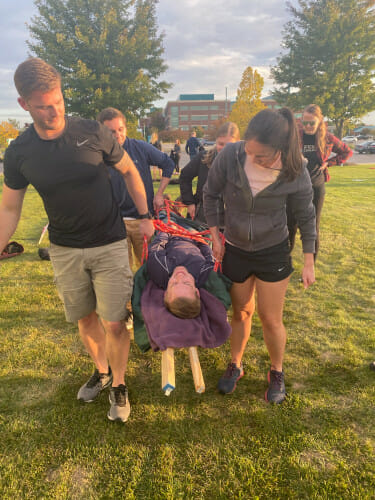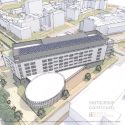Physician training track focuses on serving rural areas

Hope Villard, a Wisconsin Academy for Rural Medicine student, examines Henry Bessert at Aurora BayCare, in Green Bay in 2019. The program was developed to train medical students to become practicing physicians in rural underserved areas in Wisconsin. UW SMPH
When it comes to helping Wisconsin residents and the state’s economy, you Can’t Stop a Badger. See how UW–Madison scientists conduct cutting-edge research and outreach programs that deliver tangible benefits for Wisconsinites and the world. Follow along using #CantStopABadger on social media. Your support can help us continue this work.
In Wisconsin, only seven percent of physicians have rural practices, according to the Wisconsin Council on Medical Education and Workforce in 2021. Further, studies show that rural populations — compared to urban dwellers — are generally sicker, poorer, older and more likely to be uninsured.
With the goal of easing these disparities, the University of Wisconsin School of Medicine and Public Health launched the Wisconsin Academy for Rural Medicine, known as WARM, in 2007, with its first graduates entering residencies in 2011.
“We recruit medical students who intend to practice rural medicine and help improve health in rural Wisconsin,” says Joseph P. Holt, MD, director of WARM. “Our students emerge prepared for residencies in any medical specialty, as rural Wisconsin health systems need physicians in many specialties, particularly family medicine, internal medicine and pediatrics.”

Madeline Brown
Madeline Brown, a third-year WARM student, exemplifies the trainee envisioned by program leaders. She has dreamed of becoming a physician since her youth in Salem, Wis. When experienced a serious knee injury while playing varsity volleyball, medical professionals helped her recuperate and return to her sport.
Wanting to help patients in a similar way, Brown went on to earn a bachelor’s degree in biomedical science with a double-minor in chemistry and Spanish at UW–La Crosse. As an undergraduate, she shadowed medical professionals at Gundersen Health System and volunteered on medical and public health missions in Guatemala.
“I realized my ability to connect with people was a gift I could not let fall by the wayside. I loved meeting new people from different walks of life, learning from them and figuring out ways I could give back to them,” she recalls. “I also loved the challenge that (pre-)medicine provided; it always pushed me to be a better person. I grew more conscientious of who I was because I knew who — and what — I wanted to become.”
Brown adds, “The fact that the SMPH integrates public health into its curriculum was a huge draw — I wanted that extra knowledge because I realized, the better I understand the community around me and which factors determine their health, the better doctor I can be.”
Hailing from a small town and wanting to eventually live in a small community “where everyone knows everyone,” with ample outdoor recreation nearby, Brown chose the WARM program.
“The program matched my lifestyle and goals, including how and where I want to raise my family, all while striving to combat the growing shortage of providers in rural Wisconsin,” says Brown, whose training is based in Marshfield, Wisconsin, with clinical rotations in several small towns.
Noting that continuity of care is a “must-have” in her career, she says, “WARM’s training has exceeded my expectations. Smaller clinics and health care teams allow for more one-on-one teaching and hands-on experiences — anything from joint injections to catching babies — and I’ve enjoyed every bit of it.”
Brown continues, “I am most interested in family medicine because it will allow me to build strong relationships while caring for a variety of patients — kids, adults, whole families, elderly people. The field is conducive to being a ‘jack-of-all trades,’ as there isn’t always the ability to refer out, especially considering how far some patients would have to travel to get to another facility. I feel most passionate about promoting healthy lifestyles and empowering patients to set goals and make lifestyle changes to reach those goals.”
Further, Brown wants to incorporate teaching and mentoring into her career because many dedicated mentors have helped her along the way. She shares gratitude for her strong support system, including her family, fiancé, friends, former coaches and others.
Four campuses
The four-year WARM program — a subset of the SMPH’s MD program — accepts 26 medical students per year. Each student spends Phase 1 of the curriculum at the main campus in Madison and spends Phases 2 and 3 at one of three locations: Aurora BayCare Medical Center in Green Bay, Gundersen Health System in La Crosse or Marshfield Clinic Health System in Marshfield.
WARM students also complete clinical rotations in small towns. Dozens of physicians play crucial roles as volunteer preceptors throughout the state.
All WARM students participate in intensive “core days,” during which they gain hands-on experiences to use throughout their careers. All Phase 2 WARM students hone ultrasound skills in Marshfield and participate in a mock disaster drill in La Crosse. And Phase 3 WARM students learn Advanced Wilderness Life Support (AWLS) in Green Bay.

Participants in the fall 2022 Advanced Wilderness Life Support course carry a mock-patient on a stretcher they improvised using available supplies.
Trevor Gauthier, Brock Gilsdorf, Danielle Hurst and Christopher Karow, who are all in their final semester of WARM in Green Bay, participated in the course.
Trainee reflections
Karow, who plans to practice pediatrics in northeast Wisconsin, says, “I’m passionate about helping patients form lifelong healthy habits. I’m also passionate about the ways in which public health initiatives can improve children’s health in an entire community, even more so in rural communities.”
Gauthier shares, “A huge strength of the WARM program is that it allows medical students like me to train in the towns and hospitals where they are considering working one day.”
He continues, “In the WARM program, a lot of our public health work has been with rural communities. For example, several classmates and I worked with the Diabetes Prevention Program through the YMCA of Door County to create and deliver a presentation to participants about the development of diabetes, its effects on the body and how lifestyle changes work to prevent the disease and its sequelae. Medicine, public health, and rural health — as a student in the WARM program, I have gained valuable experience in each of these domains.”
Gilsdorf’s choice of career was deeply influenced by the health care his father received between his diagnosis with Stage IV kidney cancer and his death, shortly after Gilsdorf’s high school graduation, at which he was the valedictorian. He was grateful that the health care team made it possible for his dad to attend the graduation ceremony — a goal he had set for himself.
“In the years since my dad’s passing, I have come to realize that when a patient and their family are in their most vulnerable moments and there is seemingly nothing left to offer, physicians always have their humanism and the ability to respect and honor their patient’s wishes,” says Gilsdorf, who plans to enter internal medicine and return to northeastern Wisconsin “to help care for the family and friends of those who raised me and helped make me who I am today.”
Alumni experiences
Calling himself “the dinosaur of the program,” Dr. H. Clay Dean was a graduate of the first WARM cohort; he completed his medical education in Marshfield and Rice Lake. Following a general surgery residency at Iowa Methodist Medical Center in Des Moines, Dean became a general surgeon at Sauk Prairie Healthcare in Prairie du Sac, Wisconsin, less than 50 miles from where he grew up.
Reflecting on his choice to enroll in WARM, he notes, “The program’s values and goals lined up well with my aspirations as a future rural physician. I felt like my training allowed me to hit the ground running when starting my residency. It allowed me to have autonomy with patient care and take ownership of the patients I was following. It also allowed me to experience multiple practices from tertiary care to community-based.”
Noting that he, his wife and their two sons love living in rural Wisconsin, Dean continues, “A rural practice is vastly different from an urban practice or tertiary-center practice. Experiencing the interactions my attendings had with their patients and understanding their concerns has helped me better serve my patients in my current practice. Not always having substantial resources in a rural community but still being able to provide my patients with great surgical care is a challenge, but one that rural general surgeons have to be able to adapt to.”
On the opposite side of Wisconsin, Breanna O’Neil, MD ’17, grew up on a farm near Plymouth, Wisconsin, and practices general surgery nearby in Manitowoc County. Like the Dean family, O’Neil, her husband and their two sons love living a rural lifestyle in the Badger State.
Originally planning to become a veterinarian, O’Neil changed course when her mother was diagnosed with breast cancer and encouraged her to “pursue medicine and take care of cancer patients.”
O’Neil says, “I saw the need for doctors to care for patients in rural Wisconsin, and I knew that I wanted to ultimately practice in this setting.”
She continues, “Through the WARM program in Green Bay, I got exposure to a variety of community practice environments in rural Wisconsin and training in social issues that impact health care uniquely in rural areas.”
Noting that rural general surgeons do everything from trauma care to appendectomies to cancer care, she says, “Fewer and fewer general surgeons want to go into a rural practice, and I think one reason is that they haven’t had the opportunity to see a rural community practice during medical school. I love operating and being able to make patients feel better by fixing a hernia or taking out a gallbladder. Nothing is more rewarding than knowing I gave my patients another wedding or graduation or visit with grandchildren by surgically treating their breast cancer or other condition. I hear all the time how grateful patients and their families are to have health care available close to home.”
WARM Success
- 252 graduates between 2011 and 2022
- 45.6% matched to residencies in Wisconsin (28% for traditional MD students)
- 50% entered primary care residencies (39.4% for traditional MD students)
- 32% entered psychiatry, obstetrics and gynecology, general surgery, and emergency medicine residencies, which are all specialties in great demand in rural areas
Post-residency:
- 82% are practicing in Wisconsin
- 49% are practicing in rural Wisconsin
- 32% are practicing near their hometowns
Subscribe to Wisconsin Ideas
Want more stories of the Wisconsin Idea in action? Sign-up for our monthly e-newsletter highlighting how Badgers are taking their education and research beyond the boundaries of the classroom to improve lives.



